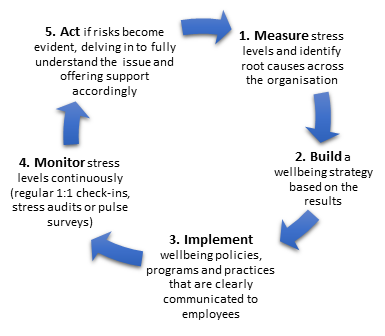The main task of organisations is to create an environment where employees feel comfortable saying “I’m struggling” - knowing that this is not a sign of weakness, but of strength.
National Stress Awareness Month is here once again, and although we know it all year round, it’s time to focus our attention to the UK’s public health dilemma that is work stress.
Not only had the number of UK workers suffering from work-related stress, anxiety or depression already been steadily increasing (from 602,000 in 2018-19 to 828,000 in 2019-2020, according to HSE), Covid-19 brought with it a second, mental health related pandemic amid a year (and counting) of lockdown, uncertainty, isolation and deteriorating work-life balance. Perhaps unsurprisingly, studies have also established that people generally found 2020 to be the most stressful year of their lives.
There may be a silver lining, however.
Inertia is a powerful force preventing people from making much-needed changes to their stress-riddled lives – could a global (double) pandemic be just the catalyst to kickstart this process? Now may be just the right time to revisit some fundamentals around stress management techniques as well as how organisations can nurture employee wellbeing for them to truly thrive at work.
How Individuals Can Fight Against (Excessive) Stress
First things first: stress is not necessarily a bad thing, nor a mental health issue in itself.
Yes, significant acute stress feels overwhelmingly unpleasant in the moment, and over time chronic stress can lead to burnout in the worst case, but no stress isn’t an optimal scenario either.
Moderate amounts of well-managed stress can indeed boost your wellbeing by providing a sense of challenge, motivation and growth. Think of the nerves felt before giving an important presentation or speech – this is good stress (also known as eustress), pushing you to be your best.
The key is keeping stress levels in this middle range of the spectrum.
Secondly, stress affects us all differently, and we also deal with it differently. As with most things, this is not a one-size-fits-all scenario; only you individually can know what works for you.
Since stress levels inevitably fluctuate in our personal and professional lives, functional coping mechanisms are key to ensuring it doesn’t get the better of us. Effective stress relievers are numerous and varied in nature, typically involving exercise, social interaction and creative activities such as music, reading, writing, cooking or even handicrafts – all of which possess a therapeutic element counteracting the build-up of stress.
It’s important to find the activity that resonates with you, and build habits to integrate those stress relievers into your daily work-life balance. As these eventually become second nature, stress busting habits will guard your resilience and ability to cope.
For more acute situations, relaxation exercises involving deep breathing and mindfulness can give immediate relief to an overexcited stress response.
Where Organisations Come Into This
As individuals, we have the most power over our own wellbeing through self-care. Organisations are not irrelevant in this equation, however. Employees dedicate roughly a third of their lives – their attention, energy and emotions – to work, meaning employers can and should guard their wellbeing.
This includes a legal duty to identify, monitor and manage workplace risks, which are increasingly psychosocial in nature - the intangible factors that have the potential to cause stress. A lack of job control or role clarity, for example; unrealistic levels of responsibility, consistent overwork, a hostile or absent line manager, as well as blurred boundaries between work and life – particularly in an extended working from home situation. Organisations that are truly literate around mental wellbeing understand the value of building an open and understanding culture around workplace mental health.
Like mental health issues, stress and burnout become much less stigmatic when openly talked about, and in turn less likely to reach a detrimental stage. While preventative approaches - such as health promotion and encouraging self-care – are always the preferred approach, potential occurrences of serious stress issues require the existence of a reactive approach as well.
Information, resources, and support pathways need to be easily accessible for those struggling. For instance, access to confidential counselling can easily be provided via employee assistance programmes or workplace mental health apps.
And because early intervention is crucial, this is where line managers can play a key role in spotting signs of a potential developing issue via continuous stress monitoring. While being confident in how to give emotional support is a hugely valuable people management skill, signposting to the appropriate sources of help is at least as important.

Don’t know how to help your employees struggling with work stress?
We've partnered with Thrive: Mental Wellbeing - the only NHS-approved wellbeing app for employees!
What line managers need to get right:
- Know that being a supportive line manager can make all the difference – it can be the reason a struggling employee feels they can stay in the job. People managers should put in the time and effort to know each direct report on a personal level, as it makes an employee much more likely to approach and confide in them, allowing for meaningful support.
- Widespread stress often comes down to resourcing, when teams are simply stretched too thin, and the amount of job resource just isn’t enough to meet job demands (the definition of work stress!). Ensure that sufficient resources exist in the right places, and that workloads are distributed fairly.
- As ambiguity is a major stressor, ensure that roles, responsibilities, expectations and priorities are clearly defined, realistic and ideally reflect personal preferences – but not overly prescriptive.
- Within guidelines, empower employees to design their day-to-day jobs and how they go about these as much as possible. Autonomy and control are critical resources guarding against the negative impact of stress.
- Actions speak louder than words – no matter what you say about reasonable working hours and taking proper breaks, the best way to encourage a healthy work-life balance is simply by role-modelling it. The same goes for showing vulnerability and asking for help when needed.
For employers committed to taking a hands-on approach, a 5-step framework should be followed:

Broadly speaking, the key to guarding against work stress lies in its definition: ensuring a high quantity and quality of resources, while keeping work demands reasonable. While resources have typically referred to the provision of adequate technology, training and headcount, individual psychological resources – resilience, optimism and an internal locus of control – are at least as important, in addition to social support, consistently identified as a key coping resource.
These psycho-social resources may be harder for employers to tap into. But when workloads and pressures are high, having these built up may be the best bet, determining whether high-stress periods take their toll on people’s health and wellbeing, or not.
Of course, starting this intervention during high-stress periods is probably too late, whereas ‘pre-emptive’ stress and resilience training can be highly effective.
The Key Takeaway
While employers have certain legal and ethical obligations, and the best ones go far beyond these, the full responsibility to relieve stress for employees does not lie with them. All of us are responsible for our own wellbeing and should make this our number one priority. Perhaps the main task of organisations is to create an environment where employees feel encouraged to do so, as well as comfortable saying “I’m struggling” - knowing that this is not a sign of weakness, but of strength.
Time to Boost Your Employees' Wellbeing!
Get data-driven insights and interventions to develop a culture of wellbeing, and learn how your organisation can obtain official recognition for nurturing your employees' wellbeing.
Recommended for you
About the Author: Sara Silvonen is a Consultant and Wellbeing Specialist at Great Place to Work UK. With an academic background in organisational psychiatry and psychology, she is particularly interested in supporting organisations in understanding the value of wellbeing-based interventions. She is passionate about mental health, having volunteered extensively in the field, and about promoting this agenda in the workplace.
Great Place to Work® specialises in helping organisations build impactful workplace cultures. We are here to help support our clients during this period of uncertainty. If you are a client, please reach out to your Account Manager who can share the tools we have in place to enable workplaces to measure and understand their current employee sentiments. If you are not a current client, stay tuned to our blog posts, Twitter, LinkedIn and publications for people practices, advice and thought leadership on how best to navigate this unprecedented time.
To learn more about our employer recognition programme, please click here.















